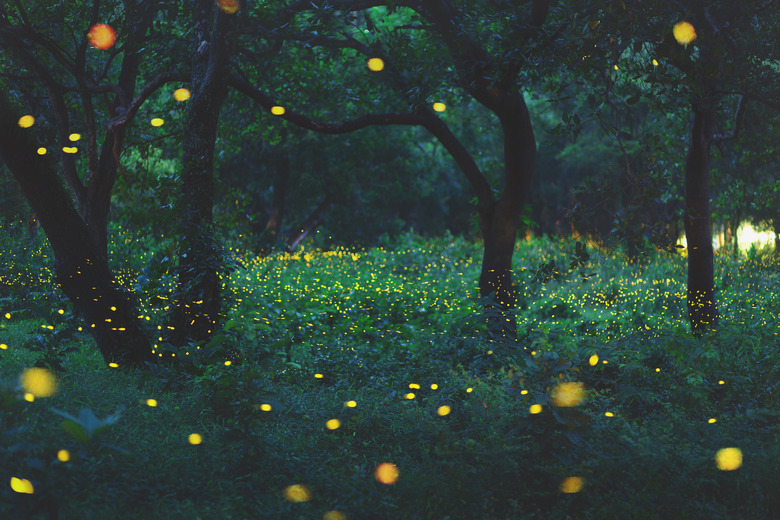An Unlikely Culprit Is Threatening Firefly Populations
Bright lights and big cities can be exciting for people. But for fireflies? Well ... those bright lights bring a little more doom and gloom.
The tiny, glowing bugs bring little flickers of light wherever they go. Unfortunately, though, over the past several decades, people have been bringing a lot more light to the world everywhere they go.
The result is a massive rise in light pollution, which a new study has found is a big problem for fireflies trying to mate. Male fireflies light up when they want to tell the world they're looking for a partner, and the females will flicker back if they like what they see. But when lights from buildings, street lights, billboards or stadiums light up night skies, it's much more difficult for fireflies to focus on the tiny lights their pals are emitting.
Along with pollution and firefly habitat destruction, it's one of the main reasons firefly populations are facing extinction.
Back up ... What is Light Pollution?
Back up ... What is Light Pollution?
Ever been in a big city and looked up at the sky on a clear night, just to realize you can't see a single star? That's because of light pollution. It's the term for all the excessive artificial light, typically from outdoor sources, that gets flashed out into the world. It can come from all kinds of light sources, and it's doing a lot of harm.
It can harm plants and animals by disrupting nocturnal hunting patterns or confusing plants that rely on both light and dark to thrive. It has also made it tougher for astronomers do to important research, and it can mess with humans' circadian rhythms, making it difficult to get enough sleep each night. It's also a massive drain of energy, and adds to our planet's carbon footprint.
And it's not just in the big cities. While it's more obvious there – that's where you'll see glares that make it impossible to look up at see stars – one study estimates that as much as 80% of the world's population lives under some amount of skyglow.
Not a Good Time to Be a Bug
Not a Good Time to Be a Bug
Though light pollution is a specific threat to the little creatures that light up the night sky, fireflies aren't the only bugs in danger right now. They're one of 400,000, or 40%, of all insect species facing extinction in what some people are calling a massive bug die-off. A combination of pollution, pesticide use and the climate crisis are upending insect habitats and making it impossible for some populations to keep going. Some of the hardest hit so far have been bees, as well as many types of butterflies and crickets.
Your first instinct might be to think that sounds kind of nice – who wants mosquitos or flies buzzing in their ears (or spreading dangerous diseases) all summer long? But annoying as some may be, insects are absolutely critical for our planet's health. They provide food for many of the world's small animals, and about 75% of the world's crops need bugs to pollinate and grow healthy and strong.
Even though this is a giant, global problem, there are still a few things you can do to make it easier for bug populations to thrive in your neighborhood:
- Make a bug hub: Give beneficial bugs a place to stay with a little bug hotel! Building one is fun and easy, and can often be done with supplies you already have around your house or school. See if some of your teachers or classmates want to get involved in making one for your school's outdoor area, or enlist some neighborhood friends to make one. The little hut will let the good bugs know they've got a safe place to stay.
- **Stay away from harmful chemicals to kill bugs:** We know that pests can be a problem, especially if you have a backyard garden. But try to encourage your family, friends or school to use natural products that will repel bugs, not fill them with harmful chemicals and eventually lessen their populations. In addition to helping bug populations, it can help you, since eating vegetables or fruits that have been doused in pesticides can be harmful to your health.
- **Turn off the lights when you don't need them:** This one is specific to fireflies, but it could help your family save on an energy bill, too! If you have lights around your house at night to light up a patio or backyard, never forget to flick the switch off when you come back inside. Or consider asking your family to limit the outdoor lights to just one or two that are really needed.
Cite This Article
MLA
Dragani, Rachelle. "An Unlikely Culprit Is Threatening Firefly Populations" sciencing.com, https://www.sciencing.com/firefly-extinction-risk-13724719/. 12 February 2020.
APA
Dragani, Rachelle. (2020, February 12). An Unlikely Culprit Is Threatening Firefly Populations. sciencing.com. Retrieved from https://www.sciencing.com/firefly-extinction-risk-13724719/
Chicago
Dragani, Rachelle. An Unlikely Culprit Is Threatening Firefly Populations last modified March 24, 2022. https://www.sciencing.com/firefly-extinction-risk-13724719/
